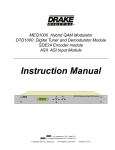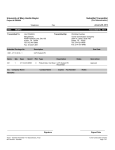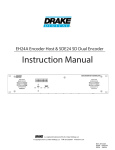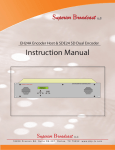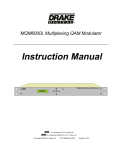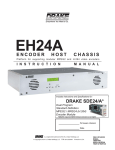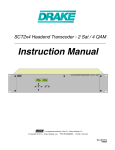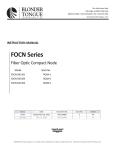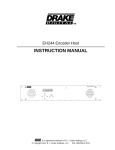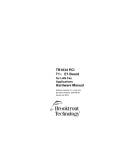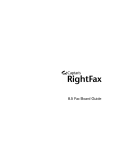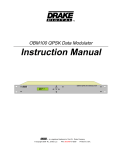Download DRAKE DQT1000 Instruction manual
Transcript
DQT1000 Digital to QAM Transcoder MQM1000 Multiplexing QAM Modulator Instruction Manual TM is a trademark of R.L. Drake LLC is a registered trademark of R.L. Drake LLC © Copyright 2007 R.L. Drake LLC P/N: 3852395C-09-2007 Printed in U.S.A. 2 Caution Statements WARNING: TO PREVENT FIRE OR ELECTRICAL SHOCK DO NOT EXPOSE TO RAIN OR MOISTURE A product and cart combination should be moved with care. Quick stops, excessive force and uneven surfaces may cause the product and cart combination to overturn. RISK OF ELECTRIC SHOCK DO NOT OPEN The lightning flash with arrow head symbol, within an equilateral triangle, is intended to alert the user to the presence of uninsulated "dangerous voltage" within the product's enclosure that may be of sufficient magnitude to constitute a risk of electric shock to persons. CAUTION: TO REDUCE THE RISK OF ELECTRIC SHOCK, DO NOT REMOVE COVER NO USER-SERVICEABLE PARTS INSIDE REFER SERVICING TO QUALIFIED PERSONNEL The exclamation point within an equilateral triangle is intended to alert the user to the presence of important operating and maintenance (servicing) instructions in the literature accompanying the product. CAUTION WARNING: TO REDUCE THE RISK OF FIRE OR ELECTRIC SHOCK, DO NOT EXPOSE THIS PRODUCT TO RAIN OR MOISTURE. DO NOT OPEN THE CABINET, REFER SERVICING TO QUALIFIED PERSONNEL ONLY. CAUTION: TO PREVENT ELECTRIC SHOCK, DO NOT USE THIS (POLARIZED) PLUG WITH AN EXTENSION CORD RECEPTACLE OR OTHER OUTLET UNLESS THE BLADES CAN BE FULLY INSERTED TO PREVENT BLADE EXPOSURE. ATTENTION: POUR PREVENIR LES CHOCS ELECTRIQUES, NE PAS UTILISER CETTE FICHE POLARISEE AVEC UN PROLONGATEUR, UNE PRISE DE COURANT OU UNE AUTRE SORTIE DE COURANT, SAUF SI LES LAMES PEUVENT ETRE INSEREES A FOND SANS EN LAISSER AUCUNE PARTIE A DECOUVERT. The DQT1000 and MQM1000 have been designed to comply with, and tested to confirm compliance to, the following satety regulations: ANSI/UL 60065, 7th Edition, dated 06/30/2004, rev. 11/20/2006. CAN/CSA - C22.2 No. 60065:03 (2006). Important Safety Instructions 1. Read Instructions—All the safety and operating instructions should be read before the product is operated. 2. Retain Instructions—The safety and operating instructions should be retained for future reference. 3. Heed Warnings—All warnings on the product and in the operating instructions should be adhered to. 4. Follow Instructions—All operating and use instructions should be followed. 5. Cleaning—Unplug this product from the wall outlet before cleaning. Do not use liquid cleaners or aerosol cleansers. Use a damp cloth for cleaning. 6. Attachments—Do not use attachments that are not recommended by the product manufacturer as they may cause hazards. 7. Water and Moisture—Do not use this product near water—for example, near a bathtub, wash bowl, kitchen sink or laundry tub; in a wet basement; or near a swimming pool; and the like. 8. Accessories—Do not place this product on an unstable cart, stand, tripod, bracket, or table. The product may fall, causing serious injury to a child or adult, and serious damage to the product. Use only with a cart, stand, tripod, bracket, or table recommended by the manufacturer, or sold with the product. Any mounting of the product should follow the manufacturer's instructions, and should use a mounting accessory recommended by the manufacturer. 9. A product and cart combination should be moved with care. Quick stops, excessive force, and uneven surfaces may cause the product and cart combination to overturn. 10. Ventilation—Slots and openings in the cabinet are provided for ventilation and to ensure reliable operation of the product and to protect it from overheating, and these openings must not be blocked or covered. The openings should never be blocked by placing the product on a bed, sofa, rug, or similar surface. This product should not be placed in a built-in installation such as bookcase or rack unless proper ventilation is provided or the manufacturer's instructions have been adhered to. 11. Power Sources—This product should be operated only from the type of power source indicated on the marking label. If you are not sure of the type of power supplied to your home, consult your product dealer or local power company. For products intended to operate from battery power, or other sources, refer to the operating instructions. 12. Grounding or Polarization—This product may be equipped with a polarized alternating-current line plug (a plug having one blade wider than the other). This plug will fit into the power outlet only one way. This is a safety feature. If you are unable to insert the plug fully into the outlet, try reversing the plug. If the plug should still fail to fit, contact your electrician to replace your obsolete outlet. Do not defeat the safety purpose of the polarized plug. Alternate Warnings—If this product is equipped with a three-wire groundingtype plug, a plug having a third (grounding) pin, the plug will only fit into a grounding-type power outlet. This is a safety feature. If you are unable to insert the plug into the outlet, contact your electrician to replace your obsolete outlet. Do not defeat the safety purpose of the grounding-type plug. 12 a. Mise à la terre ou Polarisation—Cet appareil est équipé avec un cordon d'alimentation à trois fils. Il est a brancher sur une prise ayant un connecteur a la terre. Assurez-vous que la connection a la terre ne manque pas. 13. Power-Cord Protection—Power-supply cords should be routed so that they are not likely to be walked on or pinched by items placed upon or against them, paying particular attention to cords at plugs, convenience receptacles, and the point where they exit from the product. 3 14. Outdoor Antenna Grounding—If an outside antenna or cable system is connected to the product, be sure the antenna or cable system is grounded so as to provide some protection against voltage surges and built-up static charges. Article 810 of the National Electrical Code, ANSI/NFPA 70, provides information with regard to proper grounding of the mast and supporting structure, grounding of the lead-in wire to an antenna discharge unit, size of grounding conductors, location of antenna-discharge unit, connection to grounding electrodes, and requirements for the grounding electrode. See Figure A. 15. Lightning—For added protection for this product during a lightning storm, or when it is left unattended and unused for long periods of time, unplug it from the wall outlet and disconnect the antenna or cable system. This will prevent damage to the product due to lightning and power-line surges. 16. Power Lines—An outside antenna system should not be located in the vicinity of overhead power lines, other electric light or power circuits, where it can fall into such power lines or circuits. When installing an outside antenna system, extreme care should be taken to keep from touching such power lines or circuits as contact with them may be fatal. 17. Overloading—Do not overload wall outlets, extension cords, or integral convenience receptacles as this can result in a risk of fire or electric shock. 18. Object and Liquid Entry—Never push objects of any kind into this product through openings as they may touch dangerous voltage points or short-out parts that could result in a fire or electric shock. Never spill liquid of any kind on the product. 19. Servicing—Do not attempt to service this product yourself as opening or removing covers may expose you to dangerous voltage or other hazards. Refer all servicing to qualified service personnel. 20. Damage Requiring Service—Unplug this product from the wall outlet and refer servicing to qualified service personnel under the following conditions: a. When the power-supply cord or plug is damaged, b. If liquid has been spilled, or objects have fallen into the product, c. If the product has been exposed to rain or water, d. If the product does not operate normally by following the operating instructions. Adjust only those controls that are covered by the operating instructions as an improper adjustment of other controls may result in damage and will often require extensive work by a qualified technician to restore the product to its normal operation, e. If the product has been dropped or damaged in any way, and f. When the product exhibits a distinct change in performance—this indicates a need for service. 21. Replacement Parts—When replacement parts are required, be sure the service technician has used replacement parts specified by the manufacturer or have the same characteristics as the original part. Unauthorized substitutes may result in fire, electric shock or other hazards. 22. Safety Check—Upon completion of any service or repairs to this product, ask the service technician to perform safety checks to determine that the product is in proper operating condition. 23. Wall or Ceiling Mounting—The product should be mounted to a wall or ceiling only as recommended by the manufacturer. 24. Heat—The product should be situated away from heat sources such as radiators, heat registers, stoves, or other products (including amplifiers) that produce heat. Figure A Example of antenna grounding as per National Electrical Code, ANSI/NFPA 70 NOTE TO CATV SYSTEM INSTALLERS: THIS REMINDER IS PROVIDED TO CALL THE CATV SYSTEM INSTALLER'S ATTENTION TO ARTICLE 820 - 40 OF THE NEC THAT PROVIDES GUIDELINES FOR PROPER GROUNDING AND, IN PARTICULAR, SPECIFIES THAT THE CABLE GROUND SHALL BE CONNECTED TO THE GROUNDING SYSTEM OF THE BUILDING, AS CLOSE TO THE POINT OF CABLE ENTRY AS PRACTICAL. ANTENNA LEAD IN WIRE GROUND CLAMP ANTENNA DISCHARGE UNIT (NEC SECTION 810-20) ELECTRIC SERVICE EQUIPMENT GROUNDING CONDUCTORS (NEC SECTION 810-21) GROUND CLAMPS NEC - NATIONAL ELECTRIC CODE POWER SERVICE GROUNDING ELECTRODE SYSTEM (NEC ART 250, PART H) 4 Table of Contents / Specifications TABLE OF CONTENTS 2 3 4 5 6 Caution Statements Important Safety Instructions Table of Contents / Specifications General Description Installation and Mounting / Front Panel Controls 7 8 12 13 14 Rear Panel Controls and Connections Setup and Programming Operation / Additional Features Service / If You Need To Call For Help Warranty SPECIFICATIONS DEMODULATOR (S) DQT1000 ONLY: Input Frequency Range: Channel Plans (Menu selectable): Input Channel Bandwidth: Input RF Level Range: Minimum Input Level per Mode: Maximum Input Power (sum of all channels): Input Impedance: Image rejection: Adjacent Channel Rejection: Noise Figure: Demodulation Modes: Symbol Rates: Equalizer Span: Not present - MQM1000 54 to 864 MHz. Std. CATV, HRC, IRC, or Broadcast 6 MHz. -28 dBmV to +30 dBmV 8VSB: -28dBmV, 16VSB: -25dBmV, 64QAM: -20dBmV, 256QAM: -15 dBmV. Not to exceed -16 dBm. 75 Ohms with Return Loss typically 8 dB. 40 dB. 60 dB Less than 12 dB. 8VSB,16VSB - ATSC 16QAM, 32QAM, 64QAM, 128QAM, or 256QAM - ITUA 64QAM, 256QAM, - ITUB Commonly used presets and user programmable. -6 µS to +40 µS. ASI INPUTS MQM1000-Two Inputs 270 Mbps with desired transport stream of DQT1000 ASI Option: 10.76 MS/s, ATSC, 19.37 Mbps NULL PACKET PROCESSING: DQT1000 and MQM1000 (fixed output clock mode) QAM MODULATOR Modulation Modes: 16QAM, 32QAM, 64QAM, 128QAM, 256QAM, 512QAM or 1024QAM. (See page 9 for all available combinations of QAM modes and FEC.) Symbol Rate: 1 Ms/s to 7 Ms/s. FEC: ITUA (DVB) or ITUB (DigiCipher II). I/Q Phase Error: Less than 1 degree. Carrier Suppression: 45 dB. Channel Amplitude Error: Less than 1 dB. MER: Greater than 38 dB with blind equalizer. ANALOG EAS IF INPUT Operating Input Level: +30 dBmV ±5 dB at 45.75 MHz, 75 Ohms Auto Switching Level: + 20 dBmV minimum. UPCONVERTER RF OUTPUT Output Frequency Range: Channel Plan: FCC offsets: Frequency Stability: Maximum Output Level: Minimum Output Level: Output Level Accuracy: Output Impedance: 54 MHz to 1002 MHz. Std. CATV, HRC, IRC, or Broadcast Automatic, +12.5 or +25 kHz ± 5 ppm. + 61 dBmV minimum, adjustable downward. + 45 dBmV. ± 1 dB. 75 Ohms with return loss better than 14 dB (within output filter passband). Spurious Outputs: -60 dBc from 40 MHz to 1000 MHz. Broadband Noise: Less than -12 dBmV (6 MHz BW @ ±12 MHz). Phase Noise: -101 dBc @ 10 kHz offset RS232 CONTROL Data Link: 2400, 4800, 9600, or 19,200 baud interface via serial cable. RS232 Input: DB-9 connector for connection to modem or PC. RS232 Output: DB-9 connector for connection to addtional transcoders. GENERAL Power: Weight: Size: Operating Temperature: 90 - 132 VAC/ 60 Hz, 40 W maximum. 7 pounds 19” W x 1.75” H x 11.5” D. 0 degrees C to + 50 degrees C Specifications subject to change without notice or obligation. General Description 5 MQM1000 Multiplexing QAM Modulator ASI A 26.88dB ASI B 24.52dB ENTER GENERAL DESCRIPTION The R.L. Drake model DQT1000 is a professional quality, digital headend transcoder that receives one or two ATSC, or ATSC compatible MPEG2, 8VSB or QAM signals from an off air antenna or from a CATV source. It demodulates the signals to recover the MPEG2 transport stream(s), multiplexes the MPEG2 transport streams from DEMOD A and either the second RF input (DEMOD B) or the ASI input if used, and modulates the resulting combined stream using QAM modulation followed by a built in upconverter for output to a CATV system. The model MQM1000 does not contain a RF demodulator but instead accepts one or two ATSC multiprogram transport streams via two BNC, ASI inputs. When two streams are input, the MQM1000 then multiplexes the two ATSC streams in the same manner as the DQT1000. The DQT1000 and MQM1000 provide essentially the same function as the popular DQT860 and MQM860 units. In addition, the '861' and '1000' models provide a program filter function (a new Select Program menu) and offer improved upconverter specs with phase noise reduced to a level that is compatible with QAM modes up though 1024QAM. The '1000' models provide the same features as the '861' models except that the upconverter has been upgraded to allow operation up to 1000 MHz on the output side. The new '1000' models can be used with the Drake Digital Headend Remote Control Software, version 2.6 or later, for remote controlling or remote monitoring of operating parameters. This program can also be used to download new firmware into the unit if that ever becomes desirable. The DQT1000 and MQM1000 operate in a fixed output clock mode and process null packets when required to maintain the set fixed clock rate. PCR correction is included. DIGITAL CHANNEL PROCESSING The single input DQT1000, available by special order, is ideal for digital 'channel processing' applications where a single digital video signal is received, error corrected, clocked at a user determined fixed rate and remodulated on the same or another RF channel. Applications include cleaning up a low MER QAM signal received from a CATV source or fiber link receiver, or shifting the RF frequency of a QAM modulated signal. It may be used to convert one off-air ATSC 8VSB signal to a QAM output with rate adjustment. Used in the processor mode with only one input, the DQT1000 can process ATSC, DVB, or DigiCipher II compliant MPEG2 inputs that are either VSB or QAM modulated. No multiplexing or altering of any MPEG tables is performed in this mode. Used in the non multiplexing mode, the data rate of the incoming signal can be any rate that falls within the specification range. The output rate can be set to any fixed output rate (equal to or faster than the input rate). MULTIPLEXING TWO ATSC TRANSPORT STREAMS With the second RF input/tuner/demodulator (Demod B), the DQT1000 can accept two 19.4 Mbps ATSC signals (either with 8VSB modulation or QAM modulation) and multiplex the transport streams to obtain a 38.8 Mbps 256QAM output. Thus two ATSC inputs can be output on a single 6 MHz bandwidth 256 QAM channel. Another way of combining two ATSC 19.4 Mbps streams is to receive the first stream using the 8VSB input (Demod A) and input the second stream, if available in ASI format, to the optional ASI input on The DQT1000. Again the two combined ATSC signals will be modulated at 256QAM in a 6 MHz wide channel. If it is desired to provide both ATSC signals from ASI sources, the model MQM1000 can be used. When the DQT1000 or MQM1000 multiplexes two ATSC inputs to produce a 38.8 Mbps output, no loss of picture or sound packets occurs. There is no added compression of the video or audio streams. Only the necessary control packets are rewritten to prevent duplication of MPEG2 program numbers and major and minor channel number assignments in the tables. PROGRAM FILTERING A 'Select Program' function is provided to allow the operator to select which of the MPEG programs present on the A and B input streams are to be included in the output multiplex. PSIP OPTIONS When operating in the multiplex mode, the DQT1000 or MQM1000 can be set to process PSIP information from both sources and rewrite tables containing combined PSIP information, or in cases where the off-air broadcast channels may not be transmitting some or all of the tables, it can be set to ignore and discard the PSIP tables completely, or it can be set to generate MGT and VCT tables without EIT tables. Null packet processing is applied as necessary to keep the output data rate at the desired setting. PCR correction is performed when necessary. OUTPUT The RF output is always QAM regardless of whether the input is VSB or QAM and the built-in agile upconverter provides 61 dBmV output. 6 Installation & Mounting / Front Panel Controls INSTALLATION AND MOUNTING NOTES This equipment is designed to be installed in a standard 19” rack. All models have a built in fan to provide air movement through the unit. When the unit is mounted above or below other rack mounted equipment, a 1U space should be left between the unit and the other equipment to allow ambient air flow between the units. When connecting an incoming RF signal source to the DQT1000 DEMOD A and DEMOD B (if installed) inputs, note that the antenna or CATV source must be connected to both the DEMOD A and DEMOD B input connectors. These inputs are kept separate in case the inputs need to come from different antennas or one antenna and one CATV source. Connect the AC line cord to an appropriate source of 120 volt, 50/60 Hz AC power. The DQT1000 is always on once the AC power cord is connected to its power source. F1 F2 F5 F6 MQM1000 Multiplexing QAM Modulator ASI A 26.88dB ENTER ASI B 24.52dB F3 F1, LCD Display – This display presents the selected menu screen and the parameter settings. The backlight in the display is on when power is applied. During operation, the S/N (signal to noise ratios) of the demodulator input signals are displayed. For 8VSB inputs, the threshold is about 15 dB. For QAM inputs, the threshold is about 23 dB for 64QAM and 27 dB for 256QAM. You should maintain a S/N several dB above these thresholds for reliable operation. F2, ENTER button – Use the ENTER button to enter the adjust mode or to save and load a new setting or settings after adjustment. Hold for 2 seconds until the bottom line of the display starts to flash to enter the adjust mode. After entering the adjust mode, momentarily pressing the ENTER button again will load and save any settings that may have been changed using the F5 & F6 buttons. F3 & F4, Left and Right Buttons – Use the left and right arrow buttons to navigate from screen to screen to F4 view a parameter setting. These buttons are operational in the view mode or the adjust mode. Using only these buttons will not change any parameter settings. After a short period of button inactivity, the default display will be returned. F5 & F6, Up and Down Buttons – Use the down and up arrow buttons to change the value of a viewed parameter setting. The unit must be in the adjust mode with the display flashing in order for these buttons to become active for changing a parameter setting. If the unit is not in the adjust mode, pressing the up button will display the firmware version number or pressing the down button will display the output QAM symbol rate. NOTE: The DQT1000 is shown but the MQM1000 has essentially the same front panel functionality except that certain menus will not be available for navigation. Rear Panel Connections R1 RF OUTPUT R2 EAS IN R3 DEMOD A IN R4 DEMOD B IN R5 R6 7 R7 RS232 IN ASI INPUT R9 AC POWER 120 VAC 60 Hz 30 WATTS RS232 OUT R8 DQT1000 - shown above MQM1000 - same as DQT1000 except that the MQM1000 does not have the R3 and R4 demodulator inputs or the ASI optional input. Instead it has two standard ASI inputs in place of the RF inputs on the DQT1000. The ASI inputs are type BNC female connectors. These inputs are used to input the ATSC transport streams in ASI format instead of RF. R1, RF OUTPUT – This is the high level (61 dBmV), 54 to 1002 MHz, output from the DQT1000 upconverter section. R2, EAS IN – This input may be used to input an alternate program, usually for emergency alert system requirements. This is a 44 MHz IF input and the operating level is +30 dBmV. An auto sensing switch is built in and will switch the IF to this input whenever the RF level at this jack exceeds approximately +20 dBmV at 44 MHz. The input signal can be either analog or digital. When this input is activated, the demodulators and ASI inputs are essentially switched off as the output will be determined by the IF signal input through this jack. R3, DEMOD A IN - DQT only - 54 to 864 MHz input for DEMOD A. From an off-air antenna or CATV system. R3, ASI INPUT A - MQM only. R4, DEMOD B IN - DQT ONLY - 54 to 864 MHz input for DEMOD B, if installed. From an off-air antenna or CATV system. R4, ASI INPUT B - MQM only. R5, ASI INPUT - DQT only - Optional DVB ASI format MPEG2 transport stream input. If installed, an ATSC stream from this input may be multiplexed with the stream from DEMOD A. , R6, FAN – This cooling fan pulls air through the unit for cooling. If this fan fails or is blocked the unit may become warm enough to cause the OVER TEMP alert to be activated. If the fan has failed, it should be replaced as soon as possible. Operation with an over temperature condition present for an extended period of time will lead to premature component failure even though the unit may be functioning normally when the condition is first noted. R7, RS232 IN - Connection to a PC or modem for use with remote control / monitoring program or for firmload download. R8, RS232 OUT - Loop to another DQT or MQM. R9, AC Line Cord – For connection to the nominal 120 VAC power source. This unit is designed for use in countries with 120 VAC power standards but the power supply will accept an input voltage range of 90 VAC minimum to 260 VAC maximum with a power line frequency of either 50 or 60 Hz. 8 Setup and Programming Programming and viewing of the various setup and operating parameters is accomplished using the front panel back lit, two line, sixteen character wide LCD along with the 4 arrow buttons and the ENTER button. The name of the parameter is on the top line of the display and the setting value is on the bottom line. To observe a certain parameter setting without intending to change its value, just use the left and right arrow buttons to navigate through the menus shown in the list. The current setting for each parameter is shown on the bottom line of the display. Note that depending upon certain settings, some screens are not needed and will be skipped. To make a change in the displayed parameter and its setting and if this is the initial setup, you will want to enter the ‘adjust’ mode. To do this, press the ENTER button that is located in the center of the four arrow buttons and hold in for several seconds until the display begins to flash. After you are in the adjust mode (bottom line of screen flashing) use the left and right arrows to navigate among screens and use the up and down arrows to change the parameter setting. When ENTER is pressed, the new settings will be loaded and stored and the unit will exit the ‘adjust’ mode. You may wish to not press ENTER until you have gone through all screens and settings and then press ENTER to save and load all changes in one step OR you can store just one or several parameters at a time and reenter adjust mode to set the next. Either method is acceptable. Menu Item Top display line. Use left/right arrows to navigate. Parameter Setting Choices Second display line. Must be in adjust mode to change using up/down arrows. Demod A ChanMap: CATV DQT IRC HRC Broadcast Demod A Channel: DQT # Demod A Mode: DQT VSB-8 VSB-16 QAM-16A QAM-32A QAM-64A QAM-128A QAM-256A QAM-64B QAM-256B Demod A SymRate: Preset ( If Preset, Sym Rate is... DQT 5.381119 for VSB modes 5.000000 for all QAM-A 5.056841 for QAM-64B 5.360537 for QAM-256B) Manual Demod A SymRate: x.xxxxxx (Only if Manual) DQT MULTIPLEX: DQT, MQM Disabled Demod B ASI MPEG PROGRAMS: (MULTIPLEX is not disabled) Select All Programs Select Programs (See details on pages 9 & 10) Demod B ChanMap: CATV (Only if Demod B Enabled) DQT IRC HRC Broadcast Demod B Channel: DQT # (Only if Demod B Enabled) Demod B Mode: DQT VSB-8 (Only of Demod B Enabled) VSB-16 QAM-16A QAM-32A QAM-64A QAM-128A QAM-256A QAM-64B QAM-256B Demod B SymRate: Preset (Only if Demod B Enabled) DQT (If Preset, Sym Rate is... 5.381119 for VSB modes 5.000000 for all QAM-A 5.056841 for QAM-64B 5.360537 for QAM-256B) Manual SymRate: DQT x.xxxxxx (Only of Demod B Enabled) (Only if Manual) Input B Offset: DQT, MQM 0 (Only if Multiplex Enabled) 10 20 30 40 50 60 70 80 90 PSIP: DQT, MQM Enabled Disabled Basic MGT & VCT VCT TABLE: DQT, MQM TVCT (Only if Multiplex Enabled) CVCT Major Channel: DQT, MQM Original (Only if Multiplex Enabled) RF Channel Setup and Programming, continued QAM Mode: QAM-16A QAM-32A QAM-64A QAM-128A QAM-256A QAM-512A QAM-1024A QAM-64B QAM-256B QAM-1024B Gray Encoding: DVB (Only if ITU-A selected) DAVIC QAM Sym Rate: DQT, MQM Preset (If Preset, Sym Rate is... 5.0000 for all ITU-A, 5.0570 for QAM-64B 5.3606 for QAM-256B 5.3606 for QAM-1024B) Manual QAM Sym Rate: DQT, MQM x.xxxx M Sym/Sec (Only if Manual) Interleaver: I128,J1 (Only if ITU-B selected... I128,J2 fixed at I12,J17 if ITU-A) I64,J2 I128,J3 I32,J4 I128,J4 I16,J8 I128,J5 I8,J16 I128,J6 I4,J32 I128,J7 I2,J64 I128,J8 I1,J128 Output Format: Output ChanMap: Normal CW STANDBY PRBS 15 PRBS 15M PRBS 23 PRBS 23M CATV IRC HRC Broadcast OUTPUT CHANNEL: # RF OUT: xx.x dBmV (45.0 to 62.0 dBmV) UNIT ID: # (0 thru 63) RS232 Baud Rate: 2400 4800 9600 19,200 9 DEMOD A CHANMAP: Select the setting corresponding to source of the input to DEMOD A. Choices are BROADCAST, CATV, IRC, HRC. DEMOD A CHANNEL: Select the desired channel number. DEMOD A MODE: Select the modulation type of DEMOD A input signal. Choices are VSB-8, VSB-16, QAM-256B, QAM64B, QAM-256A, QAM-128A, QAM-64A, QAM-32A, QAM16A. Off air broadcast signals will be VSB-8. In the QAM choices, the B suffix is DigiCipher II (used by most major MSOs) and the A suffix is DVB. DEMOD A SYMRATE: This is the symbol rate or baud rate of the desired input signal on the DEMOD A input. The choices are PRESET or MANUAL. If PRESET is selected, the most commonly used rates are set and can be viewed in the screen following this screen after exiting the ‘adjust’ mode. If MANUAL is selected, use the right arrow to go on to the continuation of this screen and then use the up and down arrows to set the desired symbol rate. Use PRESET for off-air VSB-8, signals. MULTIPLEX: This setting determines whether the DEMOD A input is to be multiplexed with a second input (if installed). Select DEMOD B to activate the B channel demodulator and to turn on the multiplex function. Select ASI if the second input is present at the ASI input connector and it is desired to multiplex this ASI input stream with the stream from DEMOD A. DEMOD B (if also installed) will be turned off in the ASI setting. When DEMOD B is chosen, any data at the ASI input is ignored. If the DQT1000 is being used as a processor of only one input at DEMOD A, select DISABLED. If DISABLED is selected, the next menu will be the QAM MODE menu, you may skip to that paragraph, below. MPEG PROGRAMS: This menu provides selections to determine which programs are multiplexed to form the new multiprogram transport stream output that will be supplied to the QAM modulator section. Choose the SELECT ALL PROGS setting to multiplex all programs from inputs A and B. It is the operator's responsibility to be sure that the total data rate of these programs does not exceed the maximum data rate for the output QAM mode that will be used. If the total input rate is too large, some programs will have to be dropped from the multiplex. Choose the SELECT PROGRAMS setting to allow the operator to pick which programs from the A and B inputs are to be included in the output multiplex. NOTE: At this point you may proceed through the remaining menus, below, before pressing the ENTER button to load the selected data OR you may press ENTER now and then come back to the rest of the menus. In any case, when the ENTER button is pressed, one of the following two actions will occur: A) If SELECT ALL PROGS has been selected, the DQT1000 will now read PAT tables from the two input streams and 10 Setup and Programming, continued find out which MPEG programs are defined. If you wish to view the MPEG program numbers of programs that were found, follow the procedure below: VIEWING MPEG PROGRAM NUMBERS In order to see the MPEG program numbers of incoming streams, the following procedure can be followed: 1) Press the ENTER button for 2 seconds to enter program mode. Release button. Display will be flashing. 2) Press the ENTER key again and hold. By continuing to hold in the ENTER button, the following display will be slowed down so that program numbers can be read as they scroll by. 3) A screen will be displayed that indicates: PMT PROG A xxxx or PMT PROG B xxxx. 4) The xxxx field will be a number that corresponds to the MPEG program number of a program found in the PMT table for the indicated (A or B) input. As the button is held, all entries for input A will scroll past and then entries for input B will scroll past. 5) Release button and if necessary repeat steps 1 - 4. B) If SELECT PROGRAMS was chosen, the unit will read the PAT tables from both inputs and then display: MPEG PROG XXXXX: (XXXXX is a number from 00001 to 65535) on the top line of the display. Using the right and left arrow keys, you can scroll through all 65535 possible program numbers. Don't be alarmed by the large number of possibilities because if the arrow key is held down, the scrolling will speed up so all 65535 possible numbers can be scanned in a short time - any time an entry is found at a given program number, the scrolling will slow down to give the operator time to see it and stop scrolling, if desired. Usually, all programs are known to be numbered between 01 and 20. For each MPEG program number, displayed on the top line, the bottom line, on the right, will indicate A, B, AB, or nothing. This will indicate that the program number on the top line was found in input A or B or AB for both or not in either one if blank. To select programs to be included in the output multiplex, use the up and down arrow keys to select NOT SELECTED, INPUT A, INPUT B, or INPUT A+B. If NOT SELECTED is used, then this program number will not be present in the output and any programs with this program number that are present in the A or B inputs will be filtered out. If INPUT A is selected, the A input program only is used. If INPUT B is selected, the B program is used and A filtered out. If INPUT A+B is chosen, then both are accepted if present. Note: It is OK to use this menu to set up desired program selections 'off line'. That is, with no actual input at the present time. Programs may be selected that may not currently be in the input stream but are desired at some future time. Note: It is possible to select both programs with the same program number - one from A and one from B as long as the INPUT B offset is set so that the B program number plus the offset amount does not duplicate a program number from the A input. The offset is not included in the MPEG program number display being discussed above but the offset will be added to all MPEG program numbers from the B input when they are added to the output multiplex. DEMOD B CHANMAP, DEMOD B CHANNEL, DEMOD B MODE, DEMOD B SYMRATE: See descriptions for DEMOD A above. These are equivalent settings for the DEMOD B demodulator input, when installed. INPUT B OFFSET: When the DEMOD B or ASI input has been installed and selected in the MULTIPLEX menu, this menu will be present. Because the two incoming transport streams are likely to have overlapping use of MPEG program numbers, the DQT861 or MQM861 will pass the program numbers from input A unchanged and an offset, equal to the value chosen in this menu, will be added to the program number of programs from the second input. This same offset value will also be added to the minor channel number in the VCT table for programs from the second input source. Usually an offset of 10 will be adequate but if you know there are programs in the signal input to input A using program numbers above 10, a higher offset may be required. Values between and 10 and 90, in increments of 10, are available for selection. When it is known that there is no overlap between input A and input B stream program numbers, a 0 offset setting can be used. Be cautious if this is the selection that is chosen. PSIP: This menu provides a choice of how the unit organizes the PSIP information from two ATSC streams that are being multiplexed. In the ENABLED setting, information from the MGT and VCT tables from both signals will be used to build a new table for the combined output signal. Both input streams must have these tables present in order for the unit to be able to perform this operation. EIT tables will be processed so as to provide program information, if present, for the next 12 hours. This selection is the only one that passes EIT table program information to the multiplexed output signal. RRT and STT tables from Demod A are passed through. If the broadcast station is not transmitting complete MGT and VCT tables, the ENABLED selection cannot be used. In this situation, DISABLED may be selected. In DISABLED mode, the unit does not process or output any MGT, VCT, or EIT tables. This can be a fine solution for cable systems that use set top boxes which operate from their own system channel map and have no need for these tables. MPEG program information is still processed. Some retail consumer QAM set tops operate perfectly in this mode and others may not. Setup and Programming, continued The third option is the BASIC MGT, VCT choice. When this selection is made, the DQT1000 or MQM1000 will build its own MGT and VCT tables from the incoming streams even if one or both of the streams do not contain these tables. This solution should satisfy all types of set top boxes but will not provide any EIT table program guide information. The STT and RRT tables from the source are passed through unchanged in the ENABLED mode and filtered out in the other modes. VCT TABLE: This menu is only available when ENABLED or BASIC MGT, VCT has been selected in the previous PSIP menu. You may select the TVCT - TV channel table or CVCT table for CATV. Usually the TVCT choice must be selected for ATSC input signals. MAJOR CHANNEL: This menu is not available if PSIP is disabled. When ORIGINAL is selected, the major channel number indicated in the output tables will be that sent by the original broadcaster. If OUTPUT CHANNEL is selected, the major channel number will be set to the channel number of the DQT1000 RF output channel. This setting will determine how a channel number is displayed on a consumer TV if the TV is tuning the output of the DQT1000 without a cable box. When a cable box is used, it usually does not require or use this information. QAM MODE: This menu allows the user to set the modulation type for the output. Choices range from 16-QAM through 256-QAM. A suffixes indicate DVB compliant FEC and the B suffixes indicate DigiCipher II FEC encoding. Note that when using the DQT1000 or MQM1000 in the multiplex mode, the output QAM mode usually must be 256-QAM. For CATV systems using DigiCipher II, select the QAM-256B mode. For DISH Network QAM distribution or other DVB systems using DVB set tops, choose the QAM256A mode. When used for a single input processing function, choose the output mode accordingly from any of the available options that will provide a high enough data rate. QAM SYMRATE: This menu allows selection of the output QAM baudrate or symbol rate. Set as required by the set top box. When multiplexing two ATSC input signals, in DigiCipher II, 256-QAM CATV systems, this is usually 5.3606 Ms/s. In DVB systems, the rate would be 5.264 Ms/s. In any case, the rate must be high enough to provide 11 a data bitrate of at least 38.81 Mbps (do not confuse this with the symbol rate). If the set top box requires a fixed higher rate, this may be manually set. INTERLEAVER: Sets the QAM modulator interleaver. Choose among the available selections based upon your system / set top box requirements. For typical 256-QAM. DigiCipher II CATV systems, I128, J1 is the most commonly used interleave setting but many other choices are available. This menu does not appear in the adjust mode if the QAM mode is A (DVB) as there is only one choice in the DVB standard. When not in adjust mode, this screen will display the setting in QAM - A modes as well. OUTPUT FORMAT: For normal operation, select NORMAL. For system level set up, choose CW to provide a CW carrier at the center frequency of the output channel for use in leveling a system when a QAM power meter is not available. To disable all RF output, select STANDBY. In the CW mode, the CW carrier can be measured on a spectrum analyzer without a need to apply a bandwidth correction or it can be measured with an analog meter tuned to channel center. The CW power measured will equal the channel QAM power when the modulator is returned to NORMAL output mode. Usually QAM signals are set 5 dB to 10 dB below analog NTSC channels when balancing a system. The PRBS modes provide a pseudo random binary sequence output test signal for use in laboratory testing. OUTPUT CHANMAP, OUTPUT CHANNEL: Select the desired EIA CATV channel output using these two menus. RF OUT: Select the desired RF output signal level. The available range is between 45 dBmV and 62 dBmV, selectable in 0.5 dB steps. The output accuracy is ± 1 dB. UNIT ID: Select the desired unit identification number when connecting the 'RS232 IN' connector to a PC or modem for remote control using Drake Remote Control Software. Numbers 1 thru 63 may be used. If zero (0) is selected, the PC will ignore the unit. RS232 BAUD RATE: This setting determines the baud rate at which the DQT1000 or MQM1000 communicates with the remote PC. Settings available are 2400, 4800, 9600 and 19,200. All unit 'daisy chained' to the remote PC or modem must be set to the same baud rate. 12 Operation / Additional Information OPERATION - MULTIPLEXING TWO ATSC INPUTS To use the DQT1000 or the MQM1000 to multiplex two ATSC inputs, proceed as follows: 1) Connect the off-air antenna or CATV feed to the DEMOD A and DEMOD B inputs of the DQT1000 or connect the two ASI inputs to the MQM1000. For the DQT1000 the two input connectors are separate in case the two RF signals must come from different antennas or if one signal is coming from a cable system, etc. If using a common antenna, use a good quality two way splitter to split the antenna and feed each input. 2) Plug the power cord from the unit into the power source. 3) Follow the instructions in the programming section above to set the channel map and channel number for both DEMOD A and DEMOD B - DQT1000 only. 4) Set the DEMOD SYMRATE to PRESET for both the A and B channel - DQT1000 only. 5) Set the MULTIPLEX setting to DEMOD B for the DQT1000 or to ASI for the MQM1000 6) Set the MUX OFFSET to 10. Read details in programming section to determine if you need another value. 7) Select the desired MPEG programs. (See the previous section for details.) 8) In the PSIP menu, select BASIC MGT VCT for now, this may be changed later. See programming section for detail. 9) In the VCT TABLE menu, select TVCT. 10) In the MAJOR CHANNEL menu, select OUTPUT CHANNEL. This may be changed later. 11) From the QAM MODE menu, set the QAM modulator to QAM-256B for use in a DigiCipher II environment. If DVB, use QAM-256A instead. 12) In the QAM SYMRATE menu, select PRESET. 13) Set the INTERLEAVER to I128,J1 if in a DigiCipher II environment. There is no interleaver menu when the QAM mode is set to A (DVB). 14) Set the OUTPUT FORMAT to NORMAL. 15) Set the OUTPUT CHANMAP and OUTPUT CHANNEL to the desired EIA CATV output channel. If the second program is being input to a DQT1000 via the ASI input instead of DEMOD B, the same steps apply except that the MULTIPLEX setting will be ASI and there will be no parameters to set for DEMOD B. SET TOP BOX MAPPING When setting up a program map for your set top boxes to include off-air channels that are multiplexed by the DQT1000 or MQM1000 be sure to inform the programmer that the MPEG program numbers for the programs coming in through DEMOD B or ASI B have been offset by the amount selected in the MUX OFFSET menu. As an example: If input A is providing a channel with MPEG programs 1 and 2 in the stream and input B is providing a channel with MPEG programs 1, 2, 3, 4, and 5 in the stream, and the MUX OFFSET is set to 10, then the new output signal will contain MPEG programs with program numbers of 1, 2, 11, 12, 13, 14, and 15. If the set top is not looking for the right program number, you will not receive any video! ADDITIONAL INFORMATION STANDBY MODE The DQT1000 and MQM1000 have a standby output mode which turns off the RF output. This can be used when it is desirable to temporarily disable the output without unplugging the AC line cord. Select STANDBY in the OUTPUT FORMAT menu. EAS The DQT1000 and MQM1000 provide an IF input for Emergency Alert System applications. See R2 in the rear panel connections descriptions. OVER TEMPERATURE SENSOR Temperature monitoring is built into these products. If the ventilation holes or fan output opening are blocked or the fan should stop, overheating can occur. If this condition is detected, the default LCD message will change to OVER TEMP. If this occurs, the problem should be corrected as soon as possible. The unit will remain operational but the ventilation must be restored to prevent premature part failures due to overheating. STATUS DISPLAYS When the units are not in the adjust/program mode, status displays are shown. These vary by model: DQT1000 shows DEMOD A and DEMOD B SNRs. MQM1000 shows ASI A and ASI B data presence. QQP860 - shows demod SNR and ERRORS. The ERRORS display is a five digit number that shows the number of correctable errors that were processed in a 4.5 second window. A low number is best. Pushing the UP arrow button will cause the firmware version number to display. Pressing the DOWN arrow will cause QAMSYMRATE to display - the output symbol rate of the QAM modulator. REMOTE CONTROL AND MONITORING The DQT1000 or MQM1000 may be used with the 'Drake Digital Headend Remote Control Software' program to allow remote monitoring or control. Only version 2.6 or newer are compatible with the DQT1000 or MQM1000. Connect the RS232 cable coming from the PC or modem to the RS232 IN DB9 rear panel connector. Assign a UNIT ID (1 to 63) to use the remote program. Leave at, or set to, 0 if no remote access is desired. Set the RS232 BAUD RATE to match the PC setting. If you are familiar with the program, operation will be clear. If not familiar with it, see further instructions in the insert provided with the CDROM or stored on the CDROM. OPTIONS A second RF demodulator module, PN 1002369, may be added by the Drake service department to a DQT1000 that was initially purchased with only one RF input. A DVB ASI input board, PN 1002368, is available for installation into a DQT1000. Service / If You Need To Call For Help SERVICE INFORMATION You may contact the R.L. DRAKE Service Department for additional information or assistance by calling +1 (937) 746-6990, Monday through Friday, between 8:00 A.M. and 4:00 P.M. Eastern Time, except on holidays. You may also contact the R.L. DRAKE Service Department by E-mail at the following address: [email protected] or by Telefax: +1 (937) 806-1576. IF YOU NEED TO CALL FOR HELP Call our Customer Service/Technical Support line at +1 (937) 746-6990 between 8:00 A.M. and 4:00 P.M. Eastern Time, weekdays. Please have the unit’s serial number available. We will also need to know the specifics of any other equipment connected to the unit. When calling, please have the unit up and running, near the phone if possible. Our technician(s) will likely ask certain questions to aid in diagnosis of the problem. Also, have a voltmeter handy, if possible. R.L. DRAKE also provides technical assistance by e-mail: [email protected] or by Telefax: +1 (937) 806-1576. Many of the products that are sent to us for repair are in perfect working order when we receive them. For these units, there is a standard checkout fee that you will be charged. Please perform whatever steps are applicable from the installation sections of the Owner's Manual before calling or writing—this could save unnecessary phone charges. Please do not return the unit without contacting R.L. DRAKE first: it is preferred to help troubleshoot the problem over the phone (or by mail) first, saving you both time and money. Inside the carton, enclose a note with your name, address, daytime phone number, and a description of the unit’s problem. The unit must be sent to the following address: Service Department R.L. DRAKE LLC 230 Industrial Drive Franklin, Ohio 45005 U.S.A. Be sure to include your street address which will be needed for UPS return. UPS Surface (Brown Label) takes 7-10 days to reach us depending on your location, Blue takes 2-3 days. 13 Should you want to return your unit for service, package the unit carefully using the original carton or other suitable container. Write your return address clearly on the shipping carton and on an enclosed cover letter describing the service required, symptoms or problems. Also include your daytime telephone number and a copy of your proof of purchase. The unit will be serviced under the terms of the R.L. DRAKE LLC Limited Warranty and returned to you. Red is an overnight service. Send the unit in a way that it can be traced if we can’t verify receipt of shipment. We suggest UPS or insured postal shipment. If the unit is still under the original owner’s warranty, R.L. DRAKE will pay the cost of the return shipment to you. Our return shipping policy is that we will return it UPS Brown if received Brown or by US Mail, it will be returned Blue if received Blue or Red—or it will be returned however you prefer if you furnish the return cost for the method you select. If the unit is out of warranty, use one of the following methods for return shipment: 1) You designate billing to American Express, VISA, MasterCard or Discover card; 2) You prepay the service charges with a personal check, or 3) You specify some other method of return and payment. When calling, the technician can estimate the repair charges for you over the phone. This is another good reason to call before sending a unit in for repair. Typically, equipment is repaired in five to ten working days after it arrives at R.L. DRAKE if we have all the facts. If we must call you, it may take longer. R.L. DRAKE is not responsible for damage caused by lightning, nonprofessional alterations, “acts of God”, shipping damage, poor storage/handling, etc. R.L. DRAKE will make note of any shipping damage upon receipt. You will need to send proof of purchase to receive warranty service. Typically, a copy of the invoice from an R.L. DRAKE dealer will suffice. The warranty is for the original owner only and is not transferable. 14 Warranty Three Year Limited Warranty R.L. DRAKE LLC warrants to the original purchaser this product shall be free from defects in material or workmanship for three (3) years from the date of original purchase. During the warranty period the R.L. DRAKE LLC or an authorized Drake service facility will provide, free of charge, both parts and labor necessary to correct defects in material and workmanship. At its option, R.L. DRAKE LLC may replace a defective unit. To obtain such a warranty service, the original purchaser must: (1) Retain invoice or original proof of purchase to establish the start of the warranty period. (2) Notify the R.L. DRAKE LLC or the nearest authorized service facility, as soon as possible after discovery of a possible defect, of: (a) the model and serial number, (b) the identity of the seller and the approximate date of purchase; and (c) A detailed description of the problem, including details on the electrical connection to associated equipment and the list of such equipment. (3) Deliver the product to the R.L. DRAKE LLC or the nearest authorized service facility, or ship the same in its original container or equivalent, fully insured and shipping charges prepaid. Correct maintenance, repair, and use are important to obtain proper performance from this product. Therefore carefully read the Instruction Manual. This warranty does not apply to any defect that R.L. DRAKE LLC determines is due to: (1) Improper maintenance or repair, including the installation of parts or accessories that do not conform to the quality and specifications of the original parts. (2) Misuse, abuse, neglect or improper installation. (3) Accidental or intentional damage. All implied warranties, if any, including warranties of merchantability and fitness for a particular purpose, terminate three (3) years from the date of the original purchase. The foregoing constitutes R.L. DRAKE LLC’S entire obligation with respect to this product, and the original purchaser shall have no other remedy and no claim for incidental or consequential damages, losses or expenses. Some states do not allow limitations on how long an implied warranty lasts or do not allow the exclusions or limitation of incidental or consequential damages, so the above limitation and exclusion may not apply to you. This warranty gives you specific legal rights and you may also have other rights which vary from state to state. This warranty shall be construed under the laws of Ohio. For Service, contact: R.L. DRAKE LLC 230 Industrial Drive Franklin, Ohio 45005 U.S.A. Customer Service and Parts Telephone: +1 (937) 746-6990 Telefax: +1 (937) 806-1576 World Wide Web Site: http://www.rldrake.com R.L. Drake LLC 230 Industrial Drive Franklin, Ohio 45005 U.S.A. Customer Service and Parts Telephone: +1 (937) 746-6990 Telefax: +1 (937) 806-1576 World Wide Web Site: http://www.rldrake.com















